ELLIE ETIQUETTE: USEFUL TIPS FOR VIEWING ELEPHANTS IN KRUGER (AND ELSEWHERE)
Meeting elephants in Kruger National Park are some of our most memorable wildlife encounters anywhere. Visiting game parks in Africa remains one of our favourite pastimes and our two trips to Kruger in South Africa were terrific. Bruce’s memories of parks visited in East Africa while he lived in Ethiopia as a youngster remain vivid and instilled a love of the bush. Driving around in nature, searching for wildlife and admiring the scenery is never boring or stressful.
Of the iconic wildlife encountered, elephants consistently rate at or near the top of the wish list of every visitor. But these gentle giants can be grumpy if not shown respect and can be dangerous if provoked. We have seen much bad behaviour or just a lack of common sense from fellow park visitors who do not understand what signals to watch for when in the vicinity of ellies. Park rules are given to every car upon entrance to Kruger (as well as other parks), but some folks don’t take the five minutes necessary to read them, or simply ignore them.
So from our experiences we wanted to post some tips and recommendations on how to observe elephants in Kruger (and elsewhere) without being obtrusive or bothersome.
Above: Part of a herd pausing in the road (S139), unbothered by us, but care must be taken since an infant is present. Further up: Check out the eyelashes on that dude!
GUIDED SAFARI OR SELF-DRIVE
There are two ways to visit game parks. The first is on a guided tour, which is for people who don’t want to bother with logistics, driving, shopping for supplies, cooking and the like. Having a guide means that you are being led by someone who should know how to read ellies and what is a safe distance to keep.
On private reserves, where guides know individual animals and where they can usually be found certainly makes things easy. If you have only two or three days for animal watching, a “Ferrari Safari” is great for those who can afford it on a private reserve or concession on an established national park. You’ll be chauffeured around – even off-road – resulting in some very nice pictures of the Big Five in short order before going home.
The other option is self-driving, which is for people who wish to set their own schedule and don’t mind researching, shopping, cooking and the like. Not having to share your vehicle with folks (in some cases a lot of other bodies packing the vehicle to capacity) who may have different ambitions is a plus. Or having a guide who simply races past interesting (to you) wildlife or is just not attuned to the wants and needs of his/her clients.
Self-driving is not only much more economical, but means that you are not obligated to follow a regimented schedule. Having your own privacy allows you to set your own pace. You can stop for snacks when you want, take pictures out of either side of the car easily, or spend time sitting near a pride of lions or herd of ellies, waiting for photogenic behavior. Another plus is the thrill of the hunt: the anticipation since you are the game spotters and the feeling of gratification when you find animals on your own.
But if you come across elephants blocking the road, or coming towards you, some guidance on how to behave is quite useful.
These two are solitary bull elephants, just feeding and flapping their ears to keep cool. But in both cases their path brought them slowly towards us, so it was a simple decision to get out of their way when they approached too close for comfort. The one on the left was encountered on the very ellie-rich H7, near the Tamboti Tented Camp and the big fellow on the right was just north of the Letaba River Bridge on the H1-6.
MEETING ELEPHANTS IN KRUGER:
BE CONSIDERATE AND AWARE
Since you are on the elephant’s home ground, it’s up to you to be a considerate guest. For your own safety, give ellies lots of personal space when you encounter them. It’s exciting to happen upon them, but approach slowly. Slow, steady movements and no noise are very important around any wildlife, but especially around elephants. Assess where they are heading and their mood.
Elephants tend to travel in straight lines, whether alone or in a herd, so it’s easy to avoid a confrontation by not blocking their path. Never park across an established game path leading off the road. Switch off your car engine and enjoy the experience, keeping an eye out both to the sides of the vehicle and behind since these large animals can materialize out of the bush very quietly from any direction.
We have found ourselves surrounded by elephants in Kruger on a few occasions. It’s not a big deal. If you remains calm and quiet, the drama will only be in your head.
The above two pictures (and the family snap further up) were all taken while Fung made a video (click here) which is on our COTR YouTube Page. You can see that the road is rather narrow. We were actually surrounded by ellies. But by being calm, quiet and still, they deemed us no threat; just a minor obstacle while feeding after their afternoon bath. This was along the Biyamiti Bushveld Camp private access road (S139).
It is easy to find videos on YouTube of what not to do around elephants in Kruger and how to provoke a charge. Don’t get too close is Rule #1. Keep quiet is Rule #2. Do not honk your horn or rev your engine at them. They have the right of way, of course, and like us, they use the roads. If they are in the road, wait for them to move off the road before passing. Do not try to force your way past them. Many visitors in Kruger have been late getting back to their accommodation, missing the gate closing time simply because elephants were blocking the road. If you are driving and come across any elephants heading towards you, use your judgement. Backing up is a definite option, but we usually pull to the side of the road and give them room to pass, remaining still and quiet.
It’s their road, so one has to follow until the elephants move out of the way: photo from the S23 Biyamiti Loop.
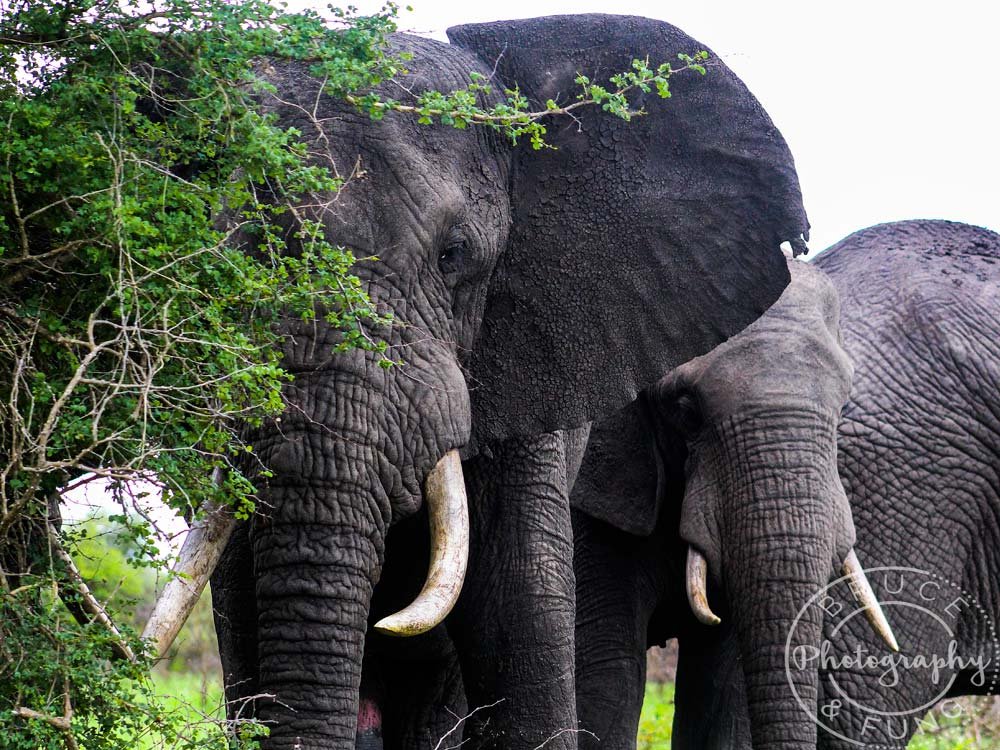
This big bull on the left was with a herd, which is usually only seen when it’s for mating purposes. We believe that the herd didn’t like his advances, because the next day we saw them, without the bull, over 20 km to the north, chugging along briskly (not feeding at all) away from where we had seen them. The picture was taken near the Talamati Bush Camp on the S145.
WHEN EXTRA SPACE IS REQUIRED
Be sure to give extra space if very young ones are in the herd or if an adult male is in musth. Musth is the male equivalent of being “in heat”, when high testosterone levels results in increased aggression and unpredictable behaviour. If you meet a bull in musth on the road walking toward you, use your reverse gear and get away safely. Also don’t drive past him. He will be highly irritable.
To recognize a bull in musth look for a profuse streaming of oily fluid down the cheek to the chin. This liquid is produced from the temporal gland located between the eye and ear. Musth males often rub the glands against trees. Temporal gland secretions alone are not a reliable indicator of musth since they can also indicate stress or excitement, so look for other signs. Another sign is a swollen temporal gland. At the peak of musth, it will be as big as a tennis ball. Also, musth males often drape their trunks over the tusks to relieve pressure on the tusks. They will be showing constantly dribbling urine or wet hind legs, so look for dark streaks running down the legs. They also give out a strong, musky odour, distinctly different from the typical elephant or dung smell, but if you notice that, you’ll be much too close.
On the left is a feeding ellie clearly showing a leaky gland, photographed on the H7 near Tamboti Tented Camp. On the right is another bull in musth, draping his trunk over a tusk to relieve pressure, taken just outside the Letaba Rest Camp front gate on the H1-6.
OBELIX!
The very first elephant that Fung and Max encountered in the wild just happened to be in musth. It was in Tshukudu Private Game Reserve, located near Hoedspruit in the region known as the Greater Kruger. This area consists of a number of private reserves that are situated along the unfenced south-western border of Kruger National Park.
We were warned that “Obelix” was in musth and would most probably be aggressive. On leaving him we would have to reverse away, since the sight of the departing rear of the vehicle often caused him to give chase. We would need to be cautious. But we weren’t worried since David, who was not only our driver/guide, but the owner of the reserve, knew him well.
We found him munching on bushes and pushing over small trees (to get the fresh leaves normally out of reach), which is normal ellie feeding behaviour, taking up most of their day. But on taking notice of us, it was obvious to see the building pressure as he began to swat at bushes, pull up vegetation and rip branches with increasing fervor until he wheeled in our direction in irritation and came at us. But when he was within three or four meters, David would bark out “Obelix!” with immediate effect. The wound-up pachyderm stopped immediately, took pause for a few breaths, and then turned to resume feeding beside the open vehicle. But within a few minutes the process would repeat itself. We were very impressed. But we would never let the encounter get to that stage if driving on our own.
Sadly, a year later, Obelix went into musth again and broke out of the reserve through an electrified fence. He happened to meet an approaching train and charged it. The inevitable result was that he was killed.
On the left is a snap by Max, showing Obelix in musth coming much too close at Tshukudu Private Reserve. On the right is the resulting picture. I was shooting into the setting sun, so needed a flash. I asked David, our Driver/Guide if I’d be aggravating him further using a strobe. David said it was OK, but my concern led me to take only two shots, though we were happy with the result.
WHAT TO WATCH FOR
Ellies will communicate their moods through their posture, stance and gestures. Retreat slowly if the elephants are showing any signs of unease. What to look for: Swinging the front foot, chin slightly up and ears slightly spread, breaking vegetation without feeding on it, coiling and uncoiling of the trunk, twisting the trunk tip back and forth, or touching its own face with its trunk. If an ellie turns towards vehicle with ears spread out 90 degrees from the body, it is not pleased. This should not be confused with slow, gentle ear flapping which relaxed elephants do to keep cool. If you notice these signs, you are probably too close for their acceptance.
Each herd or solitary bull has a well-defined safe distance and they’ll let you know if you are encroaching. Herds tend to be more spatially aware. Bulls sometimes seem a bit surprised when they first detect a nearby vehicle, so may flap their ears and take a few steps toward the vehicle, just establishing dominance; letting you know that he’s bigger than you are before trundling off. Juveniles also like to act like tough guys, practicing their belligerence, but it’s just for show and in their case, the matriarch keeps an eye on proceedings and makes the decisions, with the rest of the herd following her lead.
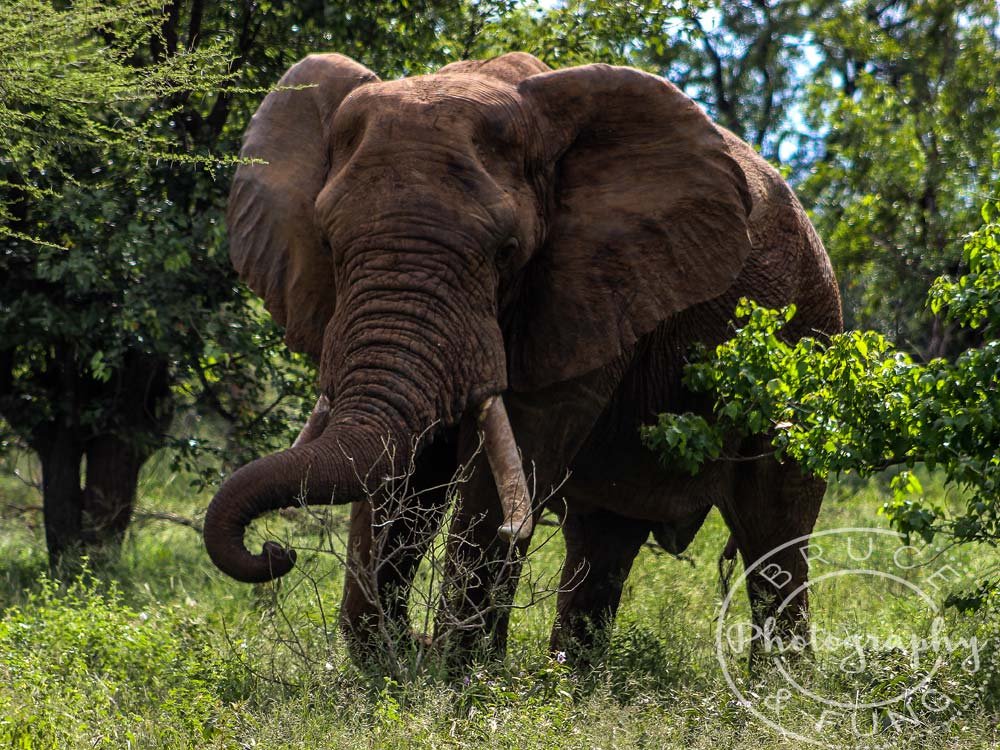
A bull elephant munching on the shrubbery along the H1-6.
The ideal situation when observing elephants in Kruger (and elsewhere) is to pick up on these more subtle signs and to keep your distance or move away. If you don’t, the elephant may become increasingly annoyed or threatened and then you force it into deciding on a flight-or-fight response. If the animal displays any of the following signs, it’s best to make a hasty retreat: Bush bashing, uprooting vegetation and throwing branches or dust towards vehicle, the tail swished vigorously or held at right angles to the body and arched, standing tall with head raised high, peering over tusks, ears cocked and trunk hanging at an acute angle. Also very not good are vocalizations such as trumpeting and abrupt head shaking so the ears flap and crack. If the tusks are pointing towards you with ears spread, this is more serious than standing tall. And of course mock charges.
CHARGE!
Warning charges can often transition into real charges and should be taken very seriously. A real charge is when the elephant lowers its head, tucks the ears back, tightly curls up its trunk and rushes full-on, pointing its tusks towards the opponent. It happens suddenly, seriously and silently, so pay attention and respond to early warnings so that this situation is avoided.
Young ellies are not very co-ordinated, learning to move and to use their trunk. This little one had some difficulty with its footwork and fell flat on his face, bouncing up immediately and flapping his ears in frustration. The other photo is a juvenile from the same herd, checking us out. This herd was one of three that we encountered repeatedly along the Biyamiti Road (S139).
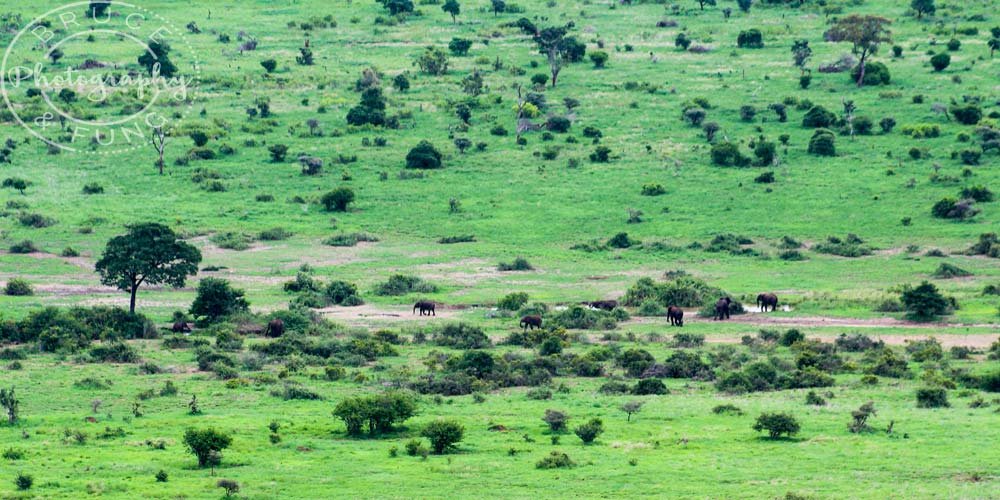
A herd visiting a waterhole, viewed from afar, atop the Nkumbe Lookout.
So please do not put yourself in needless danger. Elephants responsible for damage, injury or death are usually destroyed, whether or not they were provoked. Their future lies in your common sense.
ELEPHANTS IN KRUGER
We will write more about Kruger Park later since a visit to this amazing park – one of Africa’s largest – is best enjoyed if you plan ahead and do some research before you go. But since this post is about just one animal, we can mention where to see elephants in Kruger. The short answer is “Just about anywhere”. But we still met other folks who spent days driving around without any luck. We saw them daily during our two visits, so perhaps we’re just lucky.
They like to be near water for a daily bath, so any road along a river will provide a great chance of an ellie encounter since riverine forests offer verdant feeding, though they can wander a few kilometers away from their water source on a daily basis while feeding, often out on open grasslands since grass makes up the bulk of their daily diet.
In the dry season when riverbeds can dry up, waterholes will be visited daily. We’ve been in Kruger only during the rainy season (but saw rain just once), so the waterholes we passed were not getting much traffic and the wildlife was dispersed. Elephants can cover large distances in search of food, so don’t expect to see them in the same place twice.
This ellie (above) preferred to drink out of a puddle beside the road even though there was a river less than 100 m behind it. Go figure. The picture was taken just north of the Biyamiti Weir on the scenic and productive S23 Biyamiti Loop.
Elephants drink a lot and they eat almost constantly. With a body so large, a lot of fuel and cooling is imperative. This results in a trail of dung and large volumes of pee! The photos were taken (left) on the S25 Crocodile River Road and (right) on the H7 near Tamboti Tented Camp.
Kruger National Park covers a huge area. The park is approximately 360 kilometers (220 mi) long, with an average width of 65 kilometers (40 mi), which is virtually the size of Wales, Israel or Belgium, for scale. This space to roam and feed, along with numerous water sources and a wide variety of vegetation zones means that the park can support a large elephant population, which stands around 13,000. That’s a lot of ellies, so any visit offers a very high chance of finding elephants in Kruger, whether you are self-driving or with a guided tour.
For more info on Kruger National Park please visit the SANParks official website.
If you are in the Central Kruger region, we recommend that you pop into the lovely Letaba Camp (probably the nicest camp we have stayed in while visiting Kruger, though the area around it isn’t as productive as other parts of the park) and visit the Elephant Museum. It offers a display of the famous Magnificent Seven Big Tuskers of Kruger, all of whom have now passed (but skulls and tusks have been recovered), along with plenty of general elephant information.
So stay safe, be aware and enjoy your time shared with the elephants in Kruger – the giants of Africa.
The bull on the left seemed content to play with the grass and stare at us. Curious? Perhaps. This picture was taken along the fabulous S28 road in the south-west. On the right this bull is on the move, about to cross the S25 road in front of us one morning. He was trundling towards the nearby Crocodile River, down in the south of the park near Crocodile Bridge, where the clay-rich reddish soil in some areas gives a different colour to Ellies.
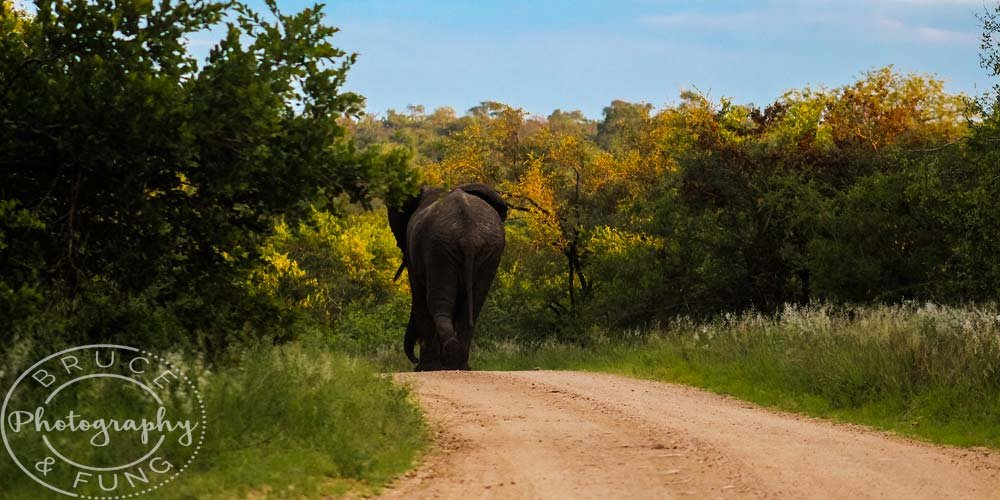
A lone bull elephant, heading towards the sunset along the Crocodile River Road (S25). The Crocodile River marks the southern border of Kruger National Park.

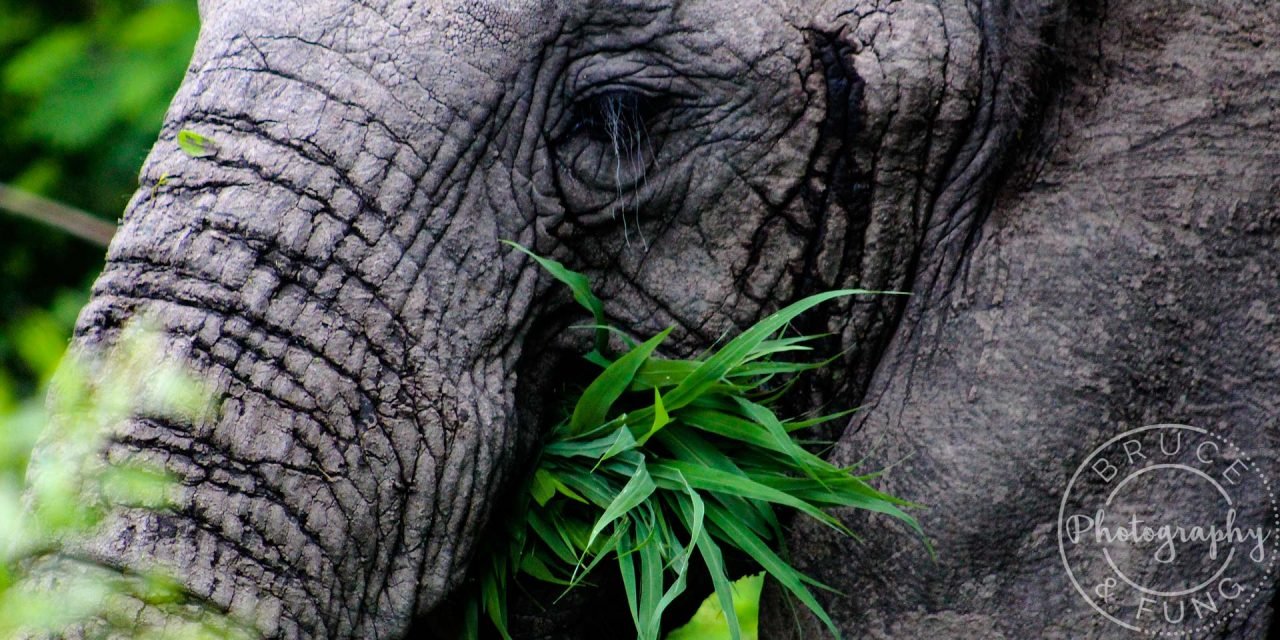


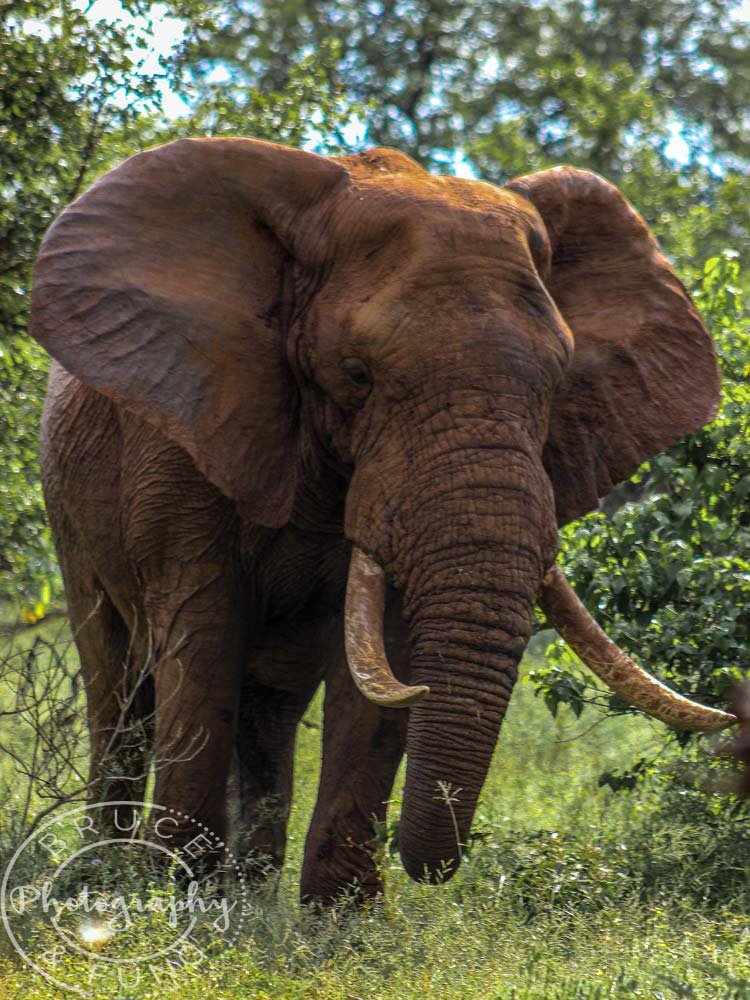
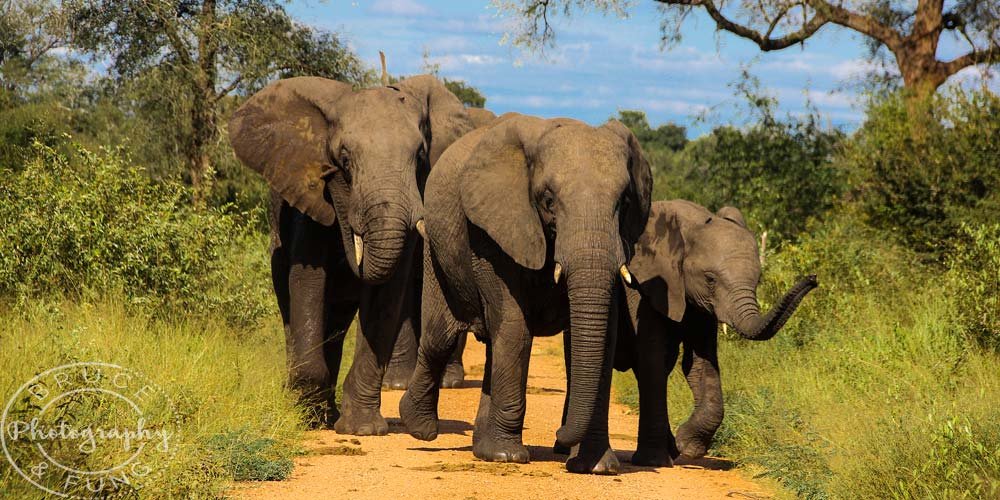



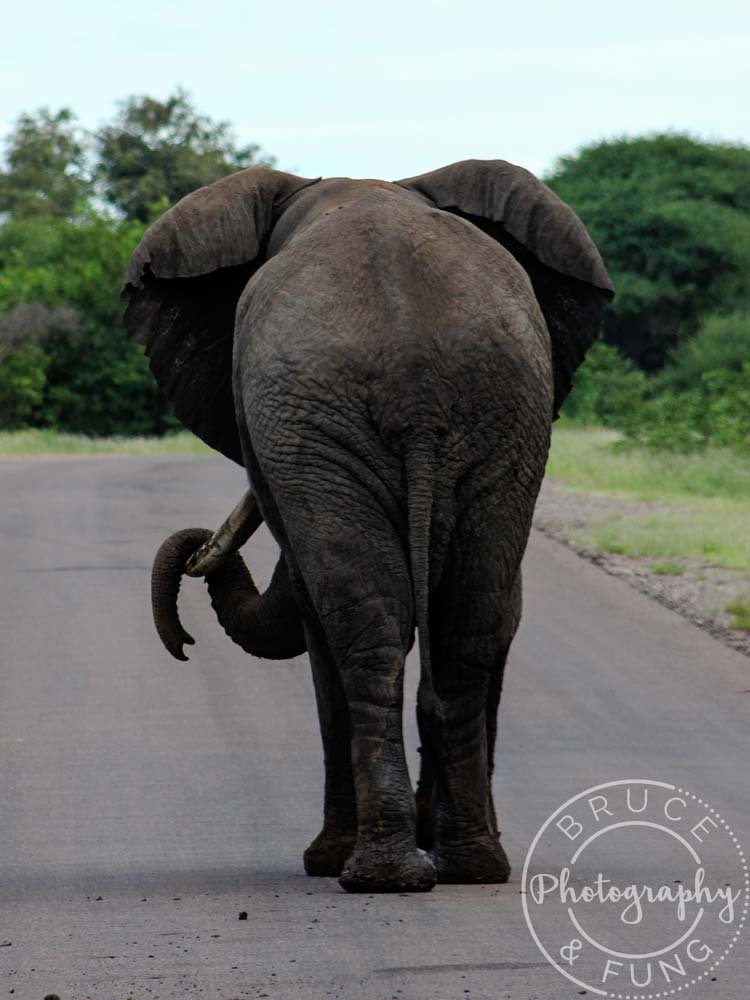


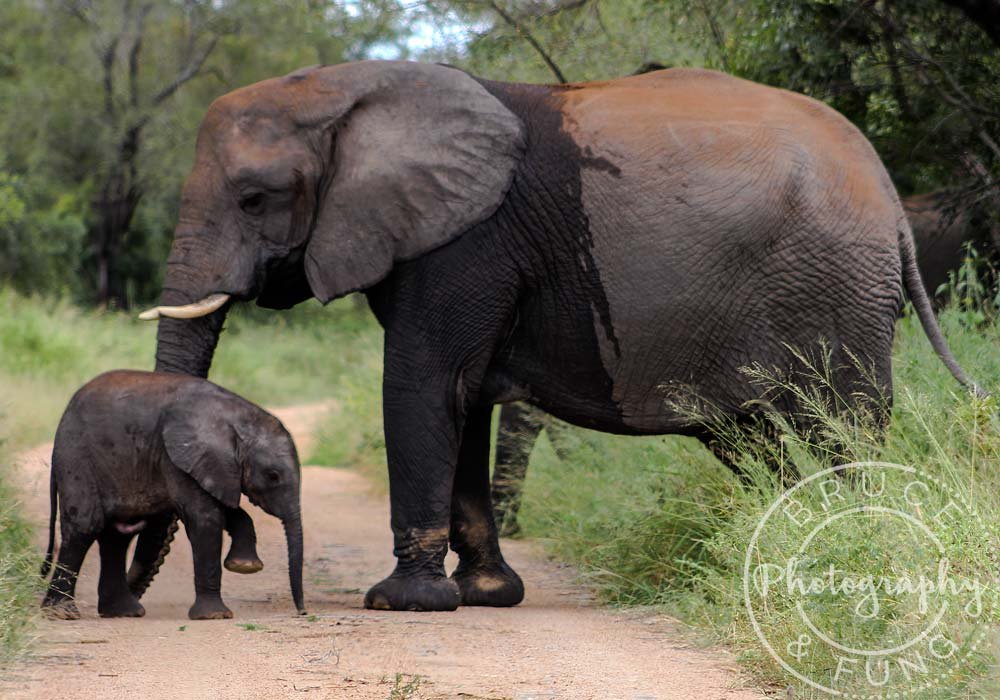
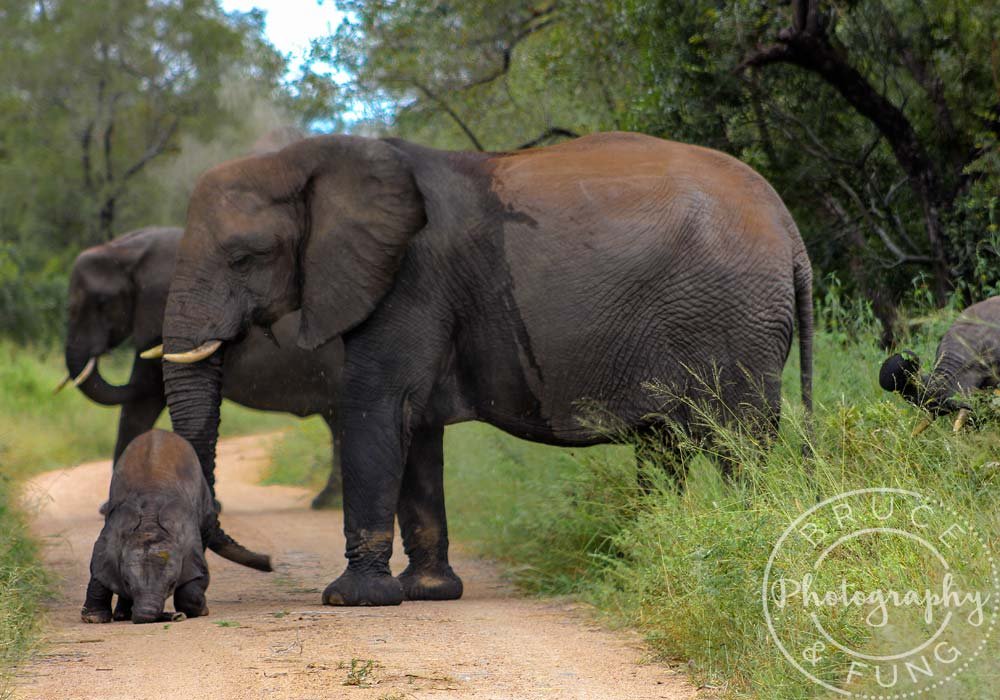
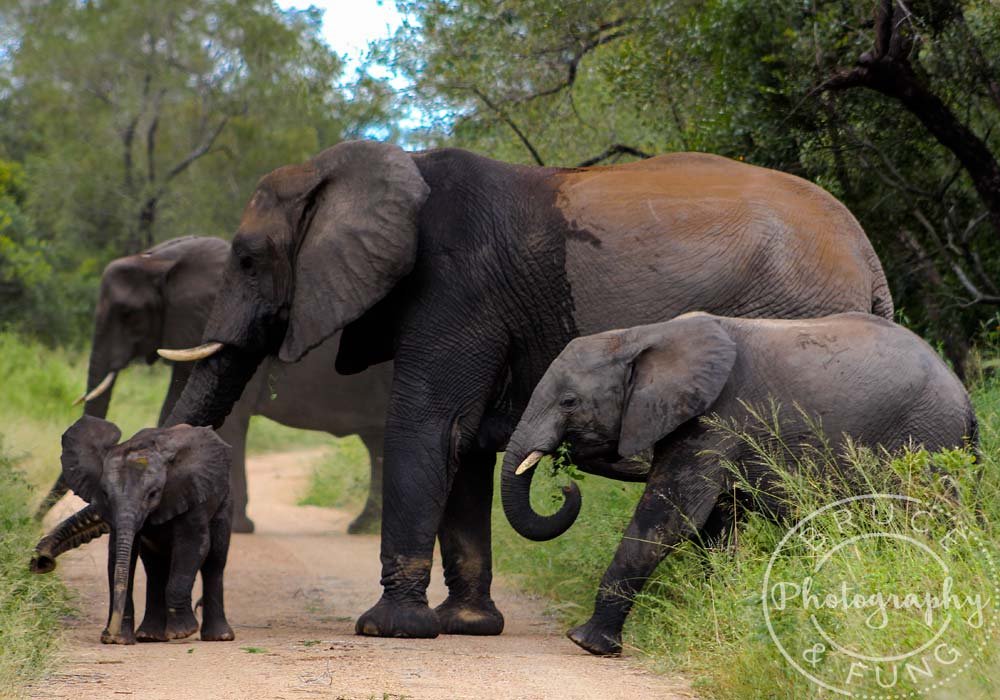



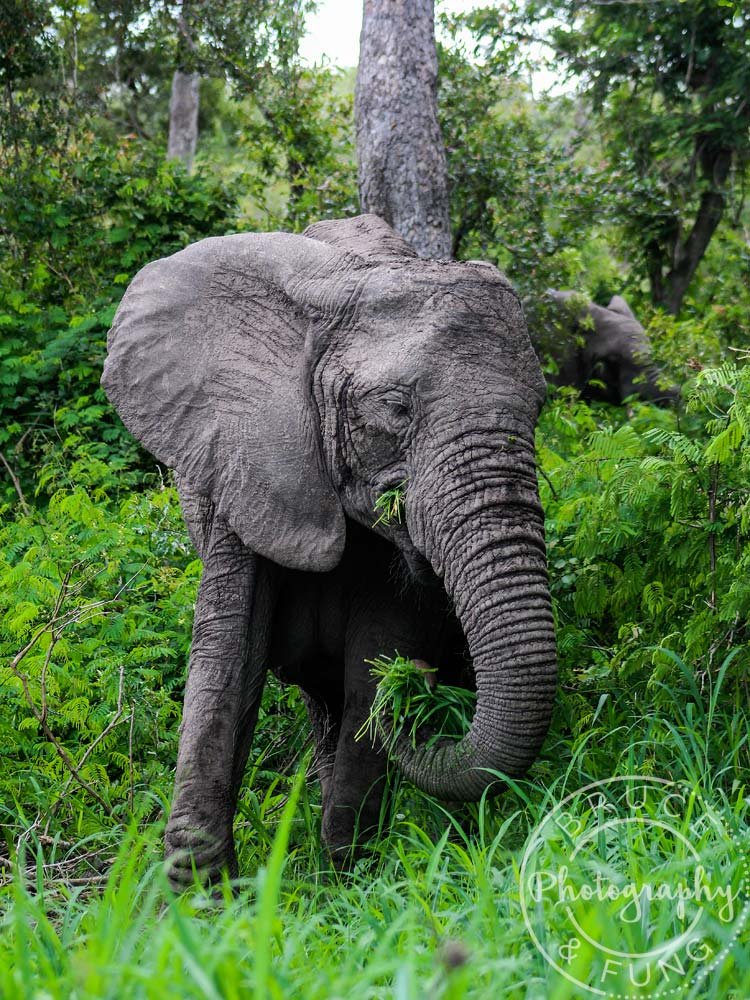





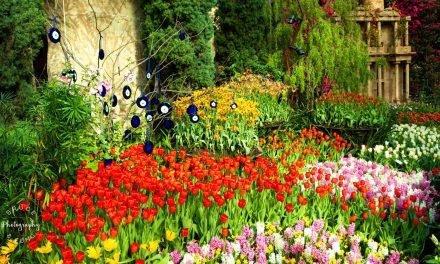










 Visit Today : 22
Visit Today : 22 This Month : 1199
This Month : 1199 This Year : 7621
This Year : 7621 Total Visit :
Total Visit :